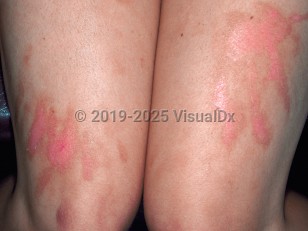Phytophotodermatitis in Child
Alerts and Notices
Important News & Links
Synopsis

Phytophotodermatitis is a cutaneous phototoxic inflammatory eruption that occurs when a photosensitizer, such as psoralen, contained in many plants, comes in contact with the skin and is followed by exposure to UVA radiation from the sun. The eruption could be considered a very localized sunburn that usually begins 12-24 hours after exposure and peaks at 48-72 hours. Phytophotodermatitis most commonly occurs in the spring and the summer when psoralens are most concentrated in plants and when UV exposure is greatest for children.
After plant contact and subsequent exposure to sunlight, a burning erythema develops that may lead to vesicle and bullae formation. This is commonly followed by postinflammatory hyperpigmentation. Four main plant families implicated as the causative agent are Umbelliferae (hogweed, cow parsley, wild parsnip, celery, wild carrots, meadow grass), Rutaceae (rue bergamot, citrus fruits, especially lime juice and lemon skin), Moraceae (figs), and Leguminoseae (scurf pea). The term "berloque dermatitis" refers to phytophotodermatitis from natural oil of bergamot – extracted from the peel of ornamental oranges – in perfumes and colognes. Since the introduction of artificial oil of bergamot, it has become rare.
Exposure to the plant sap of wild parsnip (Pastinaca sativa; "poison parsnip") can cause severe phytophotodermatitis. It is frequently found in road ditches and fields, and exposure has occurred while hiking or biking along trails and gardening (pulling weeds). When in bloom it looks similar to Queen Anne's lace or dill plant and grows to around 4 feet tall. It is common throughout the United States.
There is no age, sex, or racial predilection, although phytophotodermatitis may be more noticeable on lighter skin phototypes. The condition is benign and self-limited, and treatment is supportive. In some cases, the preceding inflammatory skin reaction may be mild, and the patient may just present with postinflammatory hyperpigmentation.
Phytophotodermatitis is a common mimicker of child abuse, with lesions similar to bruises, burns, or imprinted finger marks. Classic examples include a linear drip pattern and streaks on a child's hands, arms, and around the mouth after eating citrus ice pops or drinking juice, and a hand imprint from adults handling the sensitizing material. The eruption typically appears hours to days after the exposure, making the lesion more difficult to attribute to the contact. Thus, history of exposure is the crucial factor differentiating these lesions from abuse.
Related topic: Hogweed dermatitis
After plant contact and subsequent exposure to sunlight, a burning erythema develops that may lead to vesicle and bullae formation. This is commonly followed by postinflammatory hyperpigmentation. Four main plant families implicated as the causative agent are Umbelliferae (hogweed, cow parsley, wild parsnip, celery, wild carrots, meadow grass), Rutaceae (rue bergamot, citrus fruits, especially lime juice and lemon skin), Moraceae (figs), and Leguminoseae (scurf pea). The term "berloque dermatitis" refers to phytophotodermatitis from natural oil of bergamot – extracted from the peel of ornamental oranges – in perfumes and colognes. Since the introduction of artificial oil of bergamot, it has become rare.
Exposure to the plant sap of wild parsnip (Pastinaca sativa; "poison parsnip") can cause severe phytophotodermatitis. It is frequently found in road ditches and fields, and exposure has occurred while hiking or biking along trails and gardening (pulling weeds). When in bloom it looks similar to Queen Anne's lace or dill plant and grows to around 4 feet tall. It is common throughout the United States.
There is no age, sex, or racial predilection, although phytophotodermatitis may be more noticeable on lighter skin phototypes. The condition is benign and self-limited, and treatment is supportive. In some cases, the preceding inflammatory skin reaction may be mild, and the patient may just present with postinflammatory hyperpigmentation.
Phytophotodermatitis is a common mimicker of child abuse, with lesions similar to bruises, burns, or imprinted finger marks. Classic examples include a linear drip pattern and streaks on a child's hands, arms, and around the mouth after eating citrus ice pops or drinking juice, and a hand imprint from adults handling the sensitizing material. The eruption typically appears hours to days after the exposure, making the lesion more difficult to attribute to the contact. Thus, history of exposure is the crucial factor differentiating these lesions from abuse.
Related topic: Hogweed dermatitis
Codes
ICD10CM:
L56.2 – Photocontact dermatitis [berloque dermatitis]
SNOMEDCT:
238521005 – Phytophotodermatitis
L56.2 – Photocontact dermatitis [berloque dermatitis]
SNOMEDCT:
238521005 – Phytophotodermatitis
Look For
Subscription Required
Diagnostic Pearls
Subscription Required
Differential Diagnosis & Pitfalls

To perform a comparison, select diagnoses from the classic differential
Subscription Required
Best Tests
Subscription Required
Management Pearls
Subscription Required
Therapy
Subscription Required
References
Subscription Required
Last Updated:03/27/2018
 Patient Information for Phytophotodermatitis in Child
Patient Information for Phytophotodermatitis in Child
Premium Feature
VisualDx Patient Handouts
Available in the Elite package
- Improve treatment compliance
- Reduce after-hours questions
- Increase patient engagement and satisfaction
- Written in clear, easy-to-understand language. No confusing jargon.
- Available in English and Spanish
- Print out or email directly to your patient
Upgrade Today

Phytophotodermatitis in Child

